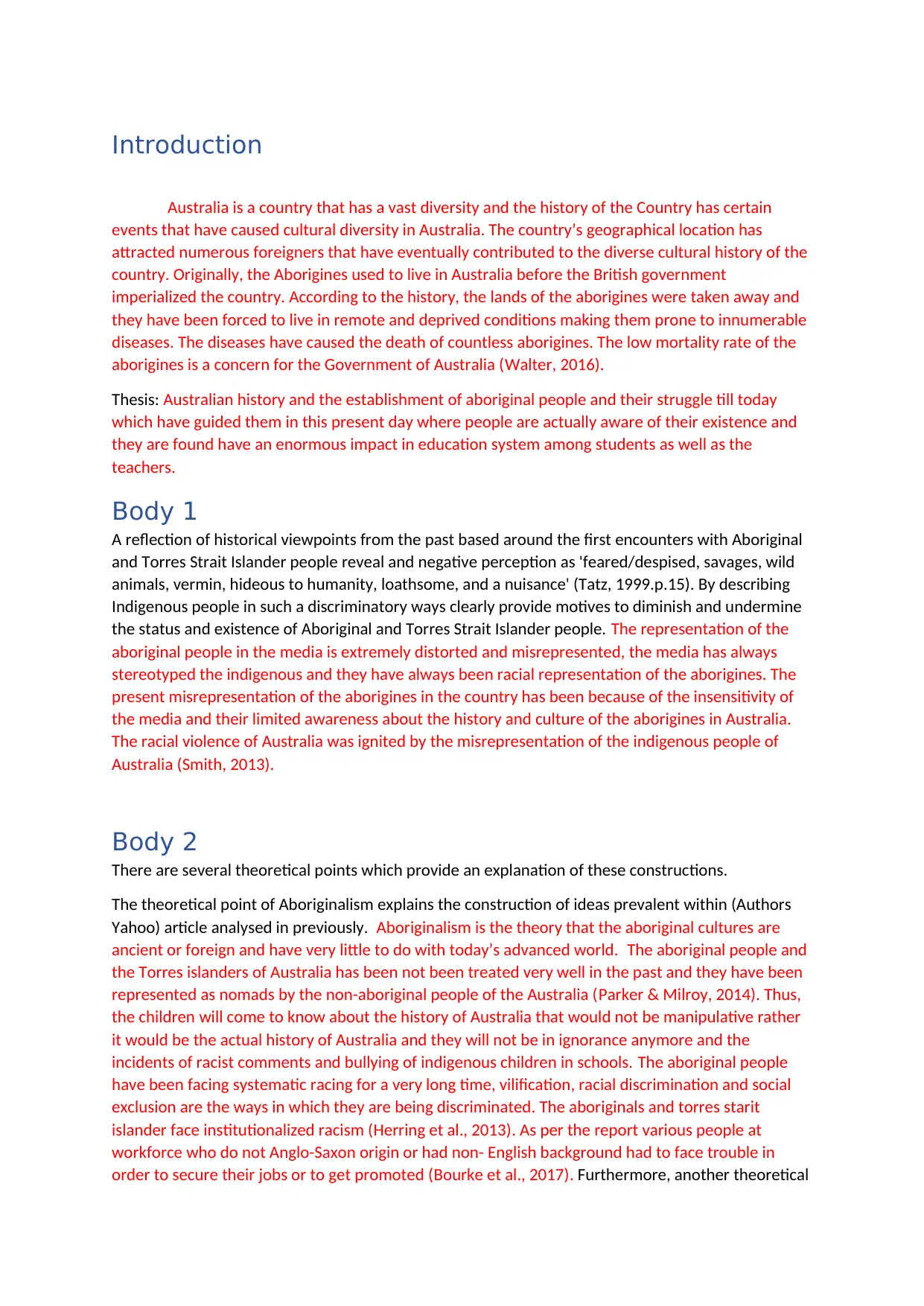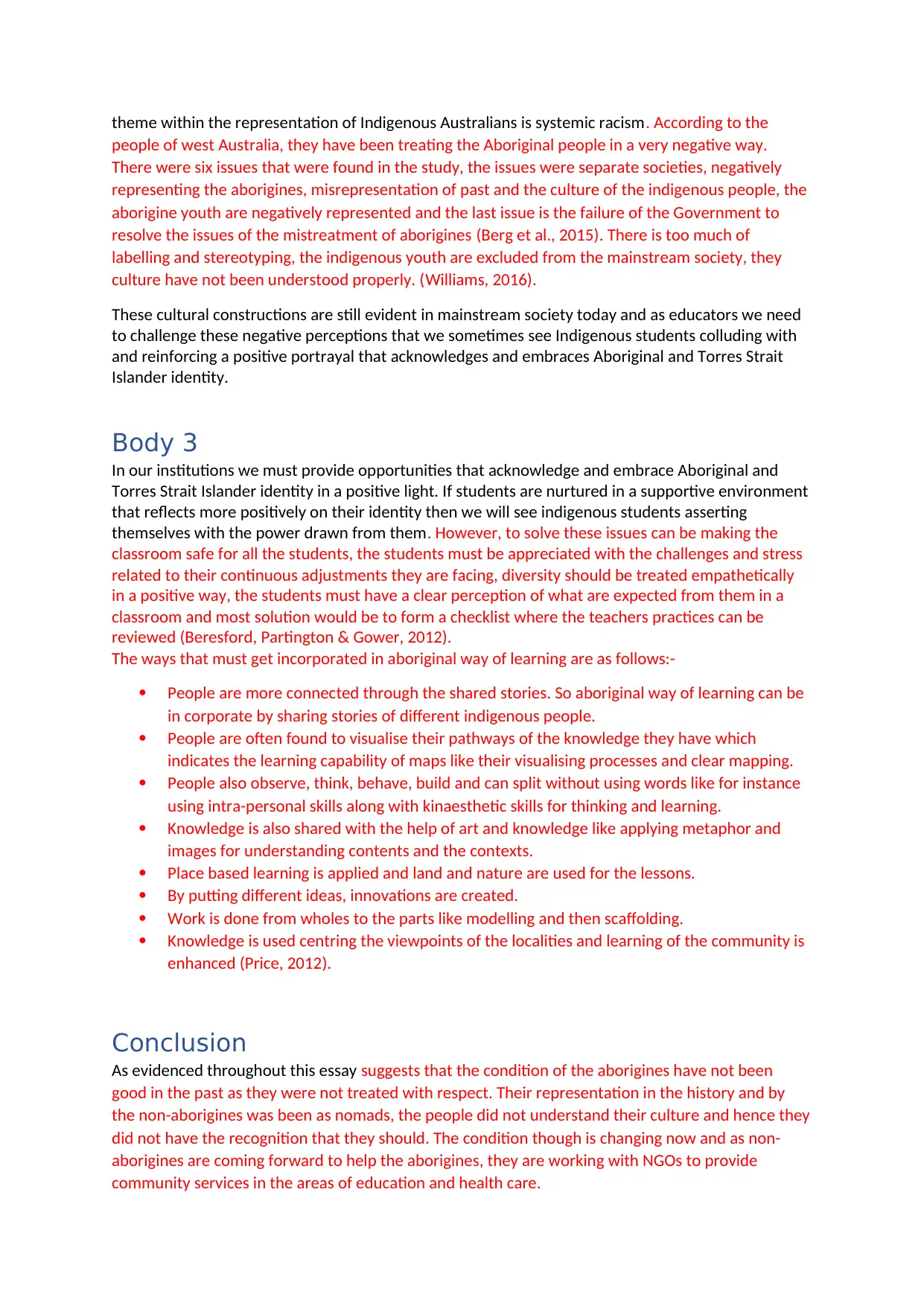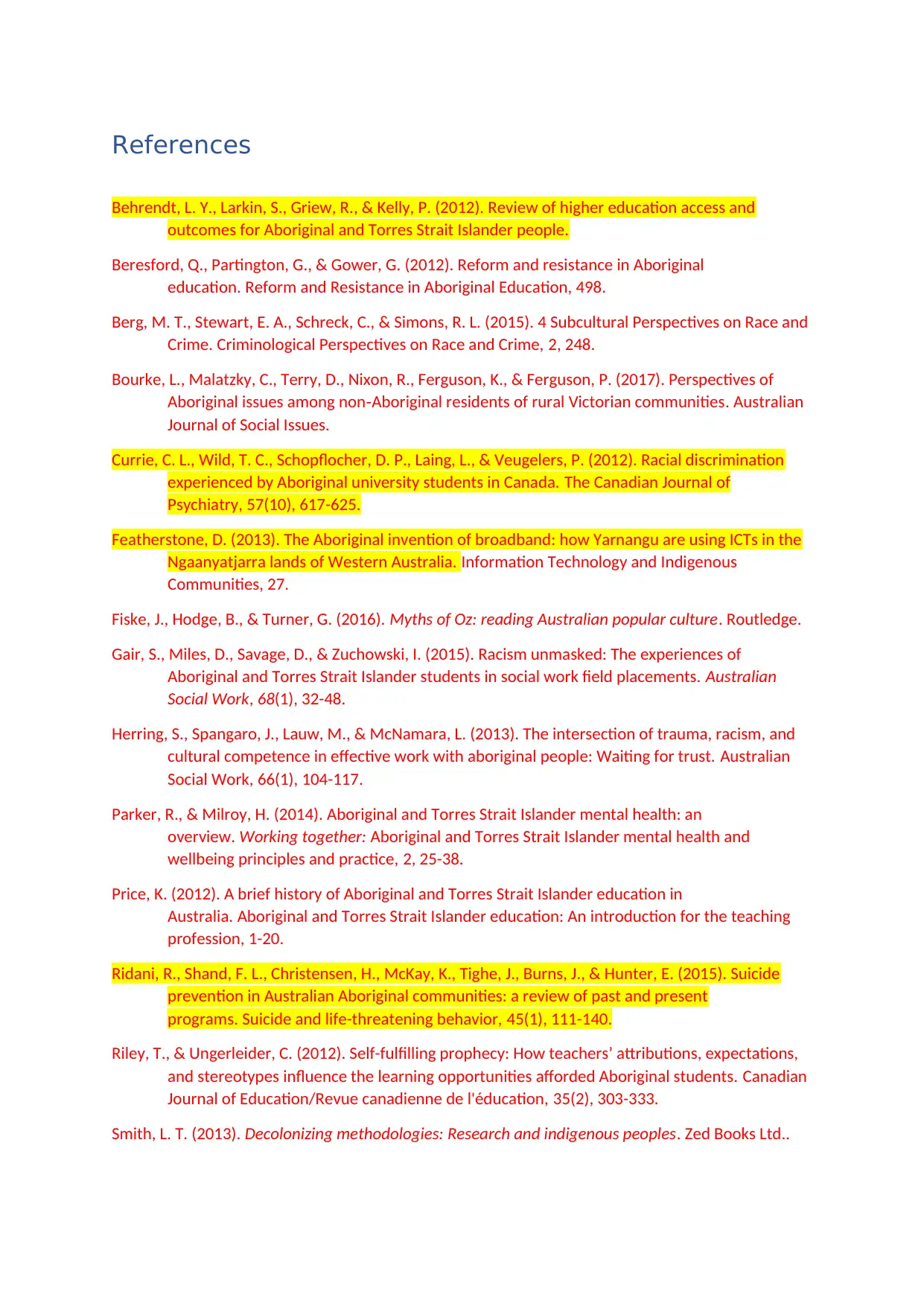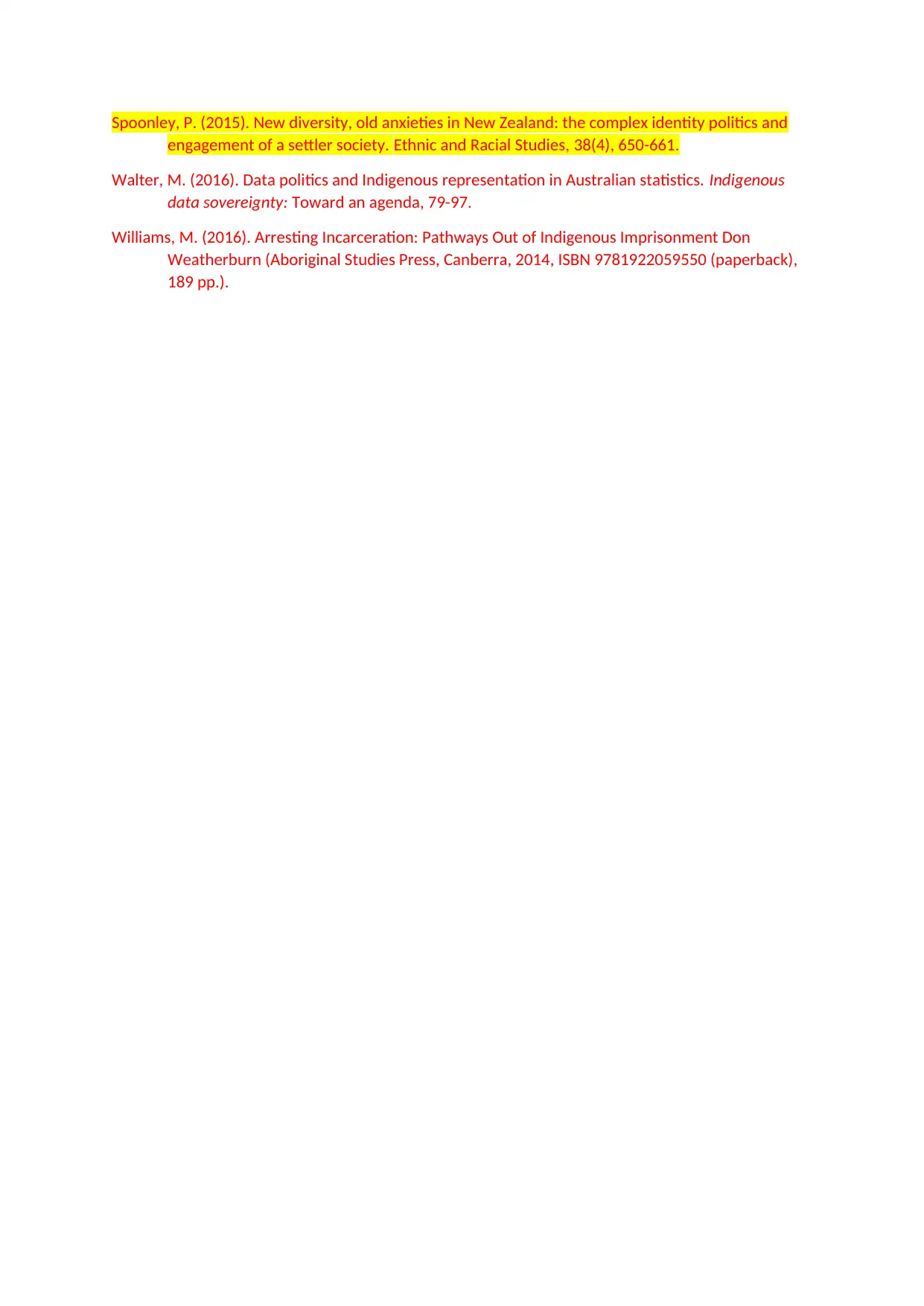The Impact of Australian History on Aboriginal People and Education
VerifiedAdded on 2020/02/24
|4
|1864
|69
Essay
AI Summary
This essay delves into the historical narrative of Australia, focusing on the Aboriginal people and their enduring struggles, tracing the evolution of cultural diversity shaped by both internal dynamics and external influences. It begins with an overview of the Aboriginal people's historical presence in Australia, examining the negative perceptions and misrepresentations perpetuated in media. The essay highlights the impact of systemic racism, and various theoretical frameworks, including Aboriginalism, to explain the construction of ideas. The essay then explores the implications of these historical and social factors on the education system, stressing the need for positive portrayals of Aboriginal identity and culturally responsive teaching. The essay also suggests ways to incorporate Aboriginal ways of learning. The conclusion reflects on the changing conditions and ongoing efforts to address the issues faced by Aboriginal people. The essay references several academic sources to support its arguments.

Introduction
Australia is a country that has a vast diversity and the history of the Country has certain
events that have caused cultural diversity in Australia. The country’s geographical location has
attracted numerous foreigners that have eventually contributed to the diverse cultural history of the
country. Originally, the Aborigines used to live in Australia before the British government
imperialized the country. According to the history, the lands of the aborigines were taken away and
they have been forced to live in remote and deprived conditions making them prone to innumerable
diseases. The diseases have caused the death of countless aborigines. The low mortality rate of the
aborigines is a concern for the Government of Australia (Walter, 2016).
Thesis: Australian history and the establishment of aboriginal people and their struggle till today
which have guided them in this present day where people are actually aware of their existence and
they are found have an enormous impact in education system among students as well as the
teachers.
Body 1
A reflection of historical viewpoints from the past based around the first encounters with Aboriginal
and Torres Strait Islander people reveal and negative perception as 'feared/despised, savages, wild
animals, vermin, hideous to humanity, loathsome, and a nuisance' (Tatz, 1999.p.15). By describing
Indigenous people in such a discriminatory ways clearly provide motives to diminish and undermine
the status and existence of Aboriginal and Torres Strait Islander people. The representation of the
aboriginal people in the media is extremely distorted and misrepresented, the media has always
stereotyped the indigenous and they have always been racial representation of the aborigines. The
present misrepresentation of the aborigines in the country has been because of the insensitivity of
the media and their limited awareness about the history and culture of the aborigines in Australia.
The racial violence of Australia was ignited by the misrepresentation of the indigenous people of
Australia (Smith, 2013).
Body 2
There are several theoretical points which provide an explanation of these constructions.
The theoretical point of Aboriginalism explains the construction of ideas prevalent within (Authors
Yahoo) article analysed in previously. Aboriginalism is the theory that the aboriginal cultures are
ancient or foreign and have very little to do with today’s advanced world. The aboriginal people and
the Torres islanders of Australia has been not been treated very well in the past and they have been
represented as nomads by the non-aboriginal people of the Australia (Parker & Milroy, 2014). Thus,
the children will come to know about the history of Australia that would not be manipulative rather
it would be the actual history of Australia and they will not be in ignorance anymore and the
incidents of racist comments and bullying of indigenous children in schools. The aboriginal people
have been facing systematic racing for a very long time, vilification, racial discrimination and social
exclusion are the ways in which they are being discriminated. The aboriginals and torres starit
islander face institutionalized racism (Herring et al., 2013). As per the report various people at
workforce who do not Anglo-Saxon origin or had non- English background had to face trouble in
order to secure their jobs or to get promoted (Bourke et al., 2017). Furthermore, another theoretical
Australia is a country that has a vast diversity and the history of the Country has certain
events that have caused cultural diversity in Australia. The country’s geographical location has
attracted numerous foreigners that have eventually contributed to the diverse cultural history of the
country. Originally, the Aborigines used to live in Australia before the British government
imperialized the country. According to the history, the lands of the aborigines were taken away and
they have been forced to live in remote and deprived conditions making them prone to innumerable
diseases. The diseases have caused the death of countless aborigines. The low mortality rate of the
aborigines is a concern for the Government of Australia (Walter, 2016).
Thesis: Australian history and the establishment of aboriginal people and their struggle till today
which have guided them in this present day where people are actually aware of their existence and
they are found have an enormous impact in education system among students as well as the
teachers.
Body 1
A reflection of historical viewpoints from the past based around the first encounters with Aboriginal
and Torres Strait Islander people reveal and negative perception as 'feared/despised, savages, wild
animals, vermin, hideous to humanity, loathsome, and a nuisance' (Tatz, 1999.p.15). By describing
Indigenous people in such a discriminatory ways clearly provide motives to diminish and undermine
the status and existence of Aboriginal and Torres Strait Islander people. The representation of the
aboriginal people in the media is extremely distorted and misrepresented, the media has always
stereotyped the indigenous and they have always been racial representation of the aborigines. The
present misrepresentation of the aborigines in the country has been because of the insensitivity of
the media and their limited awareness about the history and culture of the aborigines in Australia.
The racial violence of Australia was ignited by the misrepresentation of the indigenous people of
Australia (Smith, 2013).
Body 2
There are several theoretical points which provide an explanation of these constructions.
The theoretical point of Aboriginalism explains the construction of ideas prevalent within (Authors
Yahoo) article analysed in previously. Aboriginalism is the theory that the aboriginal cultures are
ancient or foreign and have very little to do with today’s advanced world. The aboriginal people and
the Torres islanders of Australia has been not been treated very well in the past and they have been
represented as nomads by the non-aboriginal people of the Australia (Parker & Milroy, 2014). Thus,
the children will come to know about the history of Australia that would not be manipulative rather
it would be the actual history of Australia and they will not be in ignorance anymore and the
incidents of racist comments and bullying of indigenous children in schools. The aboriginal people
have been facing systematic racing for a very long time, vilification, racial discrimination and social
exclusion are the ways in which they are being discriminated. The aboriginals and torres starit
islander face institutionalized racism (Herring et al., 2013). As per the report various people at
workforce who do not Anglo-Saxon origin or had non- English background had to face trouble in
order to secure their jobs or to get promoted (Bourke et al., 2017). Furthermore, another theoretical
Paraphrase This Document
Need a fresh take? Get an instant paraphrase of this document with our AI Paraphraser

theme within the representation of Indigenous Australians is systemic racism. According to the
people of west Australia, they have been treating the Aboriginal people in a very negative way.
There were six issues that were found in the study, the issues were separate societies, negatively
representing the aborigines, misrepresentation of past and the culture of the indigenous people, the
aborigine youth are negatively represented and the last issue is the failure of the Government to
resolve the issues of the mistreatment of aborigines (Berg et al., 2015). There is too much of
labelling and stereotyping, the indigenous youth are excluded from the mainstream society, they
culture have not been understood properly. (Williams, 2016).
These cultural constructions are still evident in mainstream society today and as educators we need
to challenge these negative perceptions that we sometimes see Indigenous students colluding with
and reinforcing a positive portrayal that acknowledges and embraces Aboriginal and Torres Strait
Islander identity.
Body 3
In our institutions we must provide opportunities that acknowledge and embrace Aboriginal and
Torres Strait Islander identity in a positive light. If students are nurtured in a supportive environment
that reflects more positively on their identity then we will see indigenous students asserting
themselves with the power drawn from them. However, to solve these issues can be making the
classroom safe for all the students, the students must be appreciated with the challenges and stress
related to their continuous adjustments they are facing, diversity should be treated empathetically
in a positive way, the students must have a clear perception of what are expected from them in a
classroom and most solution would be to form a checklist where the teachers practices can be
reviewed (Beresford, Partington & Gower, 2012).
The ways that must get incorporated in aboriginal way of learning are as follows:-
People are more connected through the shared stories. So aboriginal way of learning can be
in corporate by sharing stories of different indigenous people.
People are often found to visualise their pathways of the knowledge they have which
indicates the learning capability of maps like their visualising processes and clear mapping.
People also observe, think, behave, build and can split without using words like for instance
using intra-personal skills along with kinaesthetic skills for thinking and learning.
Knowledge is also shared with the help of art and knowledge like applying metaphor and
images for understanding contents and the contexts.
Place based learning is applied and land and nature are used for the lessons.
By putting different ideas, innovations are created.
Work is done from wholes to the parts like modelling and then scaffolding.
Knowledge is used centring the viewpoints of the localities and learning of the community is
enhanced (Price, 2012).
Conclusion
As evidenced throughout this essay suggests that the condition of the aborigines have not been
good in the past as they were not treated with respect. Their representation in the history and by
the non-aborigines was been as nomads, the people did not understand their culture and hence they
did not have the recognition that they should. The condition though is changing now and as non-
aborigines are coming forward to help the aborigines, they are working with NGOs to provide
community services in the areas of education and health care.
people of west Australia, they have been treating the Aboriginal people in a very negative way.
There were six issues that were found in the study, the issues were separate societies, negatively
representing the aborigines, misrepresentation of past and the culture of the indigenous people, the
aborigine youth are negatively represented and the last issue is the failure of the Government to
resolve the issues of the mistreatment of aborigines (Berg et al., 2015). There is too much of
labelling and stereotyping, the indigenous youth are excluded from the mainstream society, they
culture have not been understood properly. (Williams, 2016).
These cultural constructions are still evident in mainstream society today and as educators we need
to challenge these negative perceptions that we sometimes see Indigenous students colluding with
and reinforcing a positive portrayal that acknowledges and embraces Aboriginal and Torres Strait
Islander identity.
Body 3
In our institutions we must provide opportunities that acknowledge and embrace Aboriginal and
Torres Strait Islander identity in a positive light. If students are nurtured in a supportive environment
that reflects more positively on their identity then we will see indigenous students asserting
themselves with the power drawn from them. However, to solve these issues can be making the
classroom safe for all the students, the students must be appreciated with the challenges and stress
related to their continuous adjustments they are facing, diversity should be treated empathetically
in a positive way, the students must have a clear perception of what are expected from them in a
classroom and most solution would be to form a checklist where the teachers practices can be
reviewed (Beresford, Partington & Gower, 2012).
The ways that must get incorporated in aboriginal way of learning are as follows:-
People are more connected through the shared stories. So aboriginal way of learning can be
in corporate by sharing stories of different indigenous people.
People are often found to visualise their pathways of the knowledge they have which
indicates the learning capability of maps like their visualising processes and clear mapping.
People also observe, think, behave, build and can split without using words like for instance
using intra-personal skills along with kinaesthetic skills for thinking and learning.
Knowledge is also shared with the help of art and knowledge like applying metaphor and
images for understanding contents and the contexts.
Place based learning is applied and land and nature are used for the lessons.
By putting different ideas, innovations are created.
Work is done from wholes to the parts like modelling and then scaffolding.
Knowledge is used centring the viewpoints of the localities and learning of the community is
enhanced (Price, 2012).
Conclusion
As evidenced throughout this essay suggests that the condition of the aborigines have not been
good in the past as they were not treated with respect. Their representation in the history and by
the non-aborigines was been as nomads, the people did not understand their culture and hence they
did not have the recognition that they should. The condition though is changing now and as non-
aborigines are coming forward to help the aborigines, they are working with NGOs to provide
community services in the areas of education and health care.

References
Behrendt, L. Y., Larkin, S., Griew, R., & Kelly, P. (2012). Review of higher education access and
outcomes for Aboriginal and Torres Strait Islander people.
Beresford, Q., Partington, G., & Gower, G. (2012). Reform and resistance in Aboriginal
education. Reform and Resistance in Aboriginal Education, 498.
Berg, M. T., Stewart, E. A., Schreck, C., & Simons, R. L. (2015). 4 Subcultural Perspectives on Race and
Crime. Criminological Perspectives on Race and Crime, 2, 248.
Bourke, L., Malatzky, C., Terry, D., Nixon, R., Ferguson, K., & Ferguson, P. (2017). Perspectives of
Aboriginal issues among non‐Aboriginal residents of rural Victorian communities. Australian
Journal of Social Issues.
Currie, C. L., Wild, T. C., Schopflocher, D. P., Laing, L., & Veugelers, P. (2012). Racial discrimination
experienced by Aboriginal university students in Canada. The Canadian Journal of
Psychiatry, 57(10), 617-625.
Featherstone, D. (2013). The Aboriginal invention of broadband: how Yarnangu are using ICTs in the
Ngaanyatjarra lands of Western Australia. Information Technology and Indigenous
Communities, 27.
Fiske, J., Hodge, B., & Turner, G. (2016). Myths of Oz: reading Australian popular culture. Routledge.
Gair, S., Miles, D., Savage, D., & Zuchowski, I. (2015). Racism unmasked: The experiences of
Aboriginal and Torres Strait Islander students in social work field placements. Australian
Social Work, 68(1), 32-48.
Herring, S., Spangaro, J., Lauw, M., & McNamara, L. (2013). The intersection of trauma, racism, and
cultural competence in effective work with aboriginal people: Waiting for trust. Australian
Social Work, 66(1), 104-117.
Parker, R., & Milroy, H. (2014). Aboriginal and Torres Strait Islander mental health: an
overview. Working together: Aboriginal and Torres Strait Islander mental health and
wellbeing principles and practice, 2, 25-38.
Price, K. (2012). A brief history of Aboriginal and Torres Strait Islander education in
Australia. Aboriginal and Torres Strait Islander education: An introduction for the teaching
profession, 1-20.
Ridani, R., Shand, F. L., Christensen, H., McKay, K., Tighe, J., Burns, J., & Hunter, E. (2015). Suicide
prevention in Australian Aboriginal communities: a review of past and present
programs. Suicide and life-threatening behavior, 45(1), 111-140.
Riley, T., & Ungerleider, C. (2012). Self-fulfilling prophecy: How teachers’ attributions, expectations,
and stereotypes influence the learning opportunities afforded Aboriginal students. Canadian
Journal of Education/Revue canadienne de l'éducation, 35(2), 303-333.
Smith, L. T. (2013). Decolonizing methodologies: Research and indigenous peoples. Zed Books Ltd..
Behrendt, L. Y., Larkin, S., Griew, R., & Kelly, P. (2012). Review of higher education access and
outcomes for Aboriginal and Torres Strait Islander people.
Beresford, Q., Partington, G., & Gower, G. (2012). Reform and resistance in Aboriginal
education. Reform and Resistance in Aboriginal Education, 498.
Berg, M. T., Stewart, E. A., Schreck, C., & Simons, R. L. (2015). 4 Subcultural Perspectives on Race and
Crime. Criminological Perspectives on Race and Crime, 2, 248.
Bourke, L., Malatzky, C., Terry, D., Nixon, R., Ferguson, K., & Ferguson, P. (2017). Perspectives of
Aboriginal issues among non‐Aboriginal residents of rural Victorian communities. Australian
Journal of Social Issues.
Currie, C. L., Wild, T. C., Schopflocher, D. P., Laing, L., & Veugelers, P. (2012). Racial discrimination
experienced by Aboriginal university students in Canada. The Canadian Journal of
Psychiatry, 57(10), 617-625.
Featherstone, D. (2013). The Aboriginal invention of broadband: how Yarnangu are using ICTs in the
Ngaanyatjarra lands of Western Australia. Information Technology and Indigenous
Communities, 27.
Fiske, J., Hodge, B., & Turner, G. (2016). Myths of Oz: reading Australian popular culture. Routledge.
Gair, S., Miles, D., Savage, D., & Zuchowski, I. (2015). Racism unmasked: The experiences of
Aboriginal and Torres Strait Islander students in social work field placements. Australian
Social Work, 68(1), 32-48.
Herring, S., Spangaro, J., Lauw, M., & McNamara, L. (2013). The intersection of trauma, racism, and
cultural competence in effective work with aboriginal people: Waiting for trust. Australian
Social Work, 66(1), 104-117.
Parker, R., & Milroy, H. (2014). Aboriginal and Torres Strait Islander mental health: an
overview. Working together: Aboriginal and Torres Strait Islander mental health and
wellbeing principles and practice, 2, 25-38.
Price, K. (2012). A brief history of Aboriginal and Torres Strait Islander education in
Australia. Aboriginal and Torres Strait Islander education: An introduction for the teaching
profession, 1-20.
Ridani, R., Shand, F. L., Christensen, H., McKay, K., Tighe, J., Burns, J., & Hunter, E. (2015). Suicide
prevention in Australian Aboriginal communities: a review of past and present
programs. Suicide and life-threatening behavior, 45(1), 111-140.
Riley, T., & Ungerleider, C. (2012). Self-fulfilling prophecy: How teachers’ attributions, expectations,
and stereotypes influence the learning opportunities afforded Aboriginal students. Canadian
Journal of Education/Revue canadienne de l'éducation, 35(2), 303-333.
Smith, L. T. (2013). Decolonizing methodologies: Research and indigenous peoples. Zed Books Ltd..
⊘ This is a preview!⊘
Do you want full access?
Subscribe today to unlock all pages.

Trusted by 1+ million students worldwide

Spoonley, P. (2015). New diversity, old anxieties in New Zealand: the complex identity politics and
engagement of a settler society. Ethnic and Racial Studies, 38(4), 650-661.
Walter, M. (2016). Data politics and Indigenous representation in Australian statistics. Indigenous
data sovereignty: Toward an agenda, 79-97.
Williams, M. (2016). Arresting Incarceration: Pathways Out of Indigenous Imprisonment Don
Weatherburn (Aboriginal Studies Press, Canberra, 2014, ISBN 9781922059550 (paperback),
189 pp.).
engagement of a settler society. Ethnic and Racial Studies, 38(4), 650-661.
Walter, M. (2016). Data politics and Indigenous representation in Australian statistics. Indigenous
data sovereignty: Toward an agenda, 79-97.
Williams, M. (2016). Arresting Incarceration: Pathways Out of Indigenous Imprisonment Don
Weatherburn (Aboriginal Studies Press, Canberra, 2014, ISBN 9781922059550 (paperback),
189 pp.).
1 out of 4
Related Documents
Your All-in-One AI-Powered Toolkit for Academic Success.
+13062052269
info@desklib.com
Available 24*7 on WhatsApp / Email
![[object Object]](/_next/static/media/star-bottom.7253800d.svg)
Unlock your academic potential
Copyright © 2020–2025 A2Z Services. All Rights Reserved. Developed and managed by ZUCOL.




